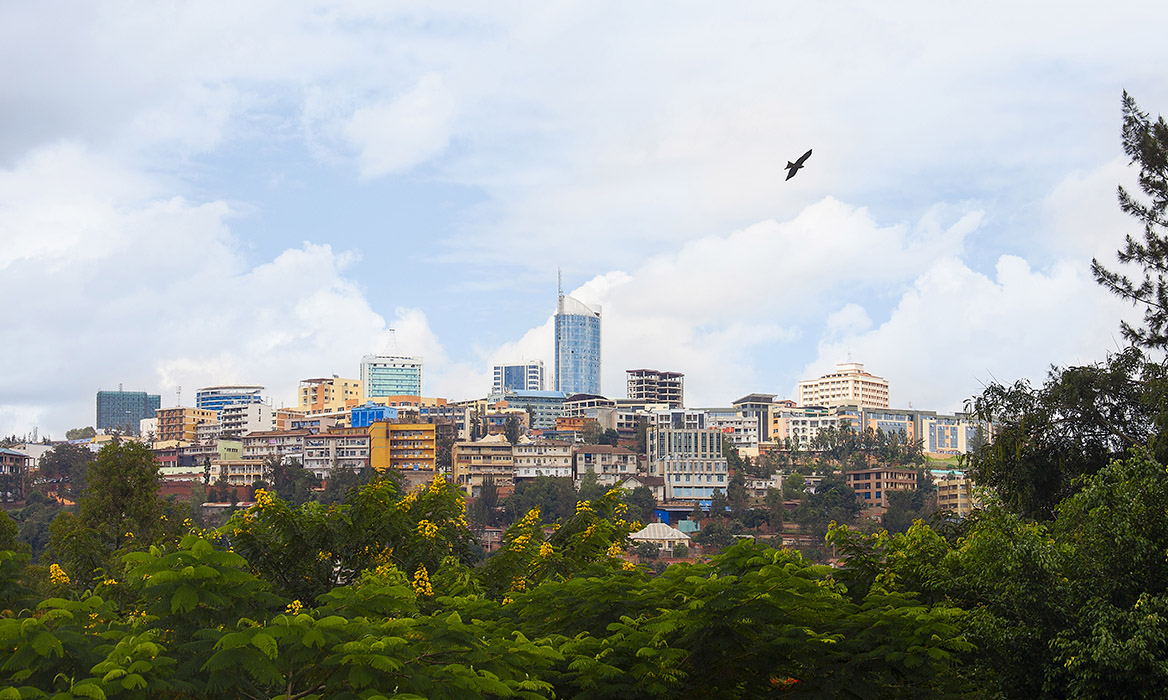Is it a bird? Is it a plane? No, it’s a commercial cargo drone returning to its droneport after delivering life-saving blood supplies.
 The sight of commercial delivery drones whizzing through the sky is much closer than you think. And nowhere more so than in Africa, where the world’s very first droneport is expected to open in Rwanda next year.
The sight of commercial delivery drones whizzing through the sky is much closer than you think. And nowhere more so than in Africa, where the world’s very first droneport is expected to open in Rwanda next year.
A collaboration between architecture firm Foster + Partners, the Swiss Federal Institute of Technology in Lausanne and its linked Afrotech initiative, the ambitious Red Line droneport project will eventually see a delivery network of drones help deliver medical and emergency supplies as well as commercial products across the country.
Jonathan Ledgard, Director of Afrotech-EPFL and Founder of Red Line, gives a guided tour through the world’s very first droneport.
Just how big is the potential for delivery drones across Africa?
There is enormous opportunity for valuable payloads to be sent by flying robot.
I expect to see two different types of commercial cargo drones. The first will be small and quick drones that can be used to deliver goods over the last mile. For example, these types of drones could be used to deliver medical emergency products, with trials already underway across Rwanda to transport life-saving blood supplies via drones.
But the bigger opportunity is on the medium-sized payloads flying between secondary towns in Africa, which will present some really interesting retail opportunities. This could connect small towns and businesses to e-commerce for the first time in a very big way.
How can delivery drones help transform local economies?
In the next five to seven years, I expect very large retailers to start serving African towns with delivery drones on a massive scale.
The droneport will serve as a shop for the town, where they can come to order and collect goods. At the same time, the droneport will put small businesses in the town on the map for the first time.
There is currently little physical connectivity between many secondary towns across Africa. Take a city such as Mwanza in Tanzania, which has a population of over 700,000 but is incredibly hard to reach from many other Tanzanian towns.
I think that layer of connectivity is going to be very significant, and will enable businesses to send goods to customers and businesses in other towns. You will still need roads, railways and other transport links but I do think carrier drones for higher value, lighter weight products will be a useful supplemental transportation system.
What inspired you to begin planning the world’s first droneport?
 Norman Foster and I sat down and said if there are going to be droneports then what should be some of their main features? We identified that technology and pricing would be key – we need to build something that is available to most towns, even the poorer ones.
Norman Foster and I sat down and said if there are going to be droneports then what should be some of their main features? We identified that technology and pricing would be key – we need to build something that is available to most towns, even the poorer ones.
Droneports should be civic in nature. They shouldn’t just be a little warehouse tucked on the edge of town. We want something that more resembles an early Victorian railway station – a place that belongs to the town and where the local community meets.
Droneports should also be built in a very sustainable way. So not just at a low cost, but with a very low carbon footprint. The initial concept we came up with is literally built from the earth, which is scooped up from the ground at the site and then made compact.
There will be hundreds of different designs and local interpretations of droneports serving different communities.
Eventually we may come to think of droneports as petrol stations. The basic structure of a petrol station is much the same across the planet, but the pumps, garage and point-of-sale are all laid out differently.
What are some of the regulatory difficulties facing drones in Africa?
In Rwanda, we have the president, military and civil aviation authority all supporting our project. We are confident that we can help establish a regulatory framework within three years, which is safe, secure and will allow drone technology to scale on the middle mile.
There are technology firms in Silicon Valley that are approaching Africa as a place which doesn’t have much air traffic, and therefore view it as an opportunity to accelerate the development of drone technology.
Except for emergency use, I don’t buy into this vision of delivery drones serving the last mile in Africa. There is huge unemployment across Africa, why would you need a robot to deliver on the last mile when a person on a bike earns money doing it?
What will be the key features of a droneport?
 Droneports will have a digital fabrication lab for repairing drones, which is likely to include a 3D printer. It may even look similar to a scene from the planet of Tatooine in Star Wars, where flying robots are being fixed in a dusty environment.
Droneports will have a digital fabrication lab for repairing drones, which is likely to include a 3D printer. It may even look similar to a scene from the planet of Tatooine in Star Wars, where flying robots are being fixed in a dusty environment.
There will be a secure operational area for the drones to be charged and for packages to be uploaded. Then there is likely to be some sort of medical space that will act as a direct interface with the local hospital for the delivery of vaccines, blood etc.
Finally, the droneport will have a post office area, where people can come to collect and drop-off packages and items.
Linking all this together will be a high level of connectivity and redundancy.
How long until we see droneports appearing across Africa?
The first droneport should be completed in Rwanda by next summer with plans to build another three or four droneports within five years.
We have some of the brightest people in the world working on this project, but this is all new and it has never been done before. Hopefully by the third or fourth droneport, we will have learnt some important lessons on how to scale.
There has been one technology breakthrough which has happened much quicker than we originally anticipated. Drones now have the ability for vertical take-off and landing.
This is really important as it means that the surface area of the droneport can be much tighter than if we had needed to included short runways. Now drones could possibly land and take off from a roof structure similar to a helipad, and from an economic point-of-view that makes the whole thing more viable.






